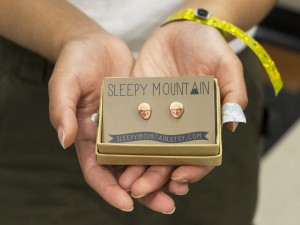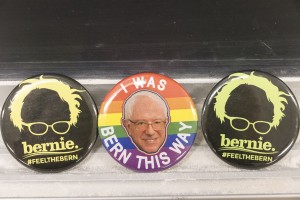A silhouette of messy white hair and black-rimmed glasses is giving Adidas and Patagonia a run for their money.
Sen. Bernie Sanders merchandise has emerged as a trend on the UCLA campus during the 2016 election cycle, filling UCLA with “Feel the Bern” gear. Students and faculty said Sanders’ disproportionate appeal to youth and the social media-fueled excitement caused the surge in his political apparel.
Gabby Martinez, a third-year political science student, said she often wears a pair of earrings printed with a small picture of Sanders’ smiling face.
The abundance of handmade pro-Sanders clothing items available online reflects the vitality of Sanders’ following, Martinez said. Whereas Clinton’s apparel is generally purchased from her online store, hundreds of handmade designs for Sanders are available on craft websites like Etsy, she said.

First-year psychology student Rebecca Handler said the enthusiasm of Sanders’ online following is the result of each candidate’s marketing strategies. The volunteer for Clinton’s campaign said Sanders aims to rouse young people who lack previous involvement using social media.
“There’s the Beliebers, the Directioners and the Bernie Bros,” Handler said. “The fact that they have a name for it just reaffirms (his marketing strategy).”
Nicolas Cazalis, member of Bruins for Bernie, said the trend is not attributable to any concerted strategy on Sanders’ part. Every campaign incorporates some artistic element to catch the public’s attention, said the second-year political science and economics student.
Cazalis said more Sanders merchandise is on campus simply because young people tend to be progressive, and Sanders is the candidate who most appeals to young voters.
Georgia Kernell, assistant communication studies professor, thinks Sanders’ relative novelty on the political scene is a greater factor than the age of either candidate’s supporters when it comes to sporting political gear.
“Clinton is the Democratic frontrunner and has been for eight years,” Kernell said. “Clinton’s supporters are not incentivized to campaign as intensely or wear as much merchandise.”

Handler said Sanders’ supporters often do not align with traditional Republican or Democratic platforms. Sanders’ followers are more excited to wear or create apparel to advertise their support, she said, because they previously felt suppressed by the political system. Handler added that the enthusiasm for Sanders gear creates the perception that the candidate has more followers than he actually does.
“People jump on the bandwagon and don’t really look into (the candidates’) policies,” Handler said. “When they see all this stuff on social media, they’ll probably be more inclined to vote for (Sanders).”
Despite the pop-culture aspect of Sanders’ campaign, Martinez said it is unfair for people to judge those who wear Bernie merchandise as politically unaware or blind followers.
“It’s like in high school when people would say, ‘Oh, you’re wearing a band shirt? Name five songs,’” Martinez said.
However, Martinez wears Bernie merchandise with the goal of starting conversations and educating peers about Bernie’s platform, she said.
For Jack Lyons, a first-year political science student and volunteer for Sanders’ campaign, it does not matter whether those who wear Bernie apparel are educated about the candidate’s platform. At the end of the day, all publicity is good publicity for his preferred political candidate, he said.
“As long as you’re actually going to show up and vote for him, wear a Bernie shirt every day, make your hair look like Bernie’s, become a 74-year-old Jewish man, whatever you need to do,” Lyons said. “If you’re not going to vote for him, you’re a poser.”
